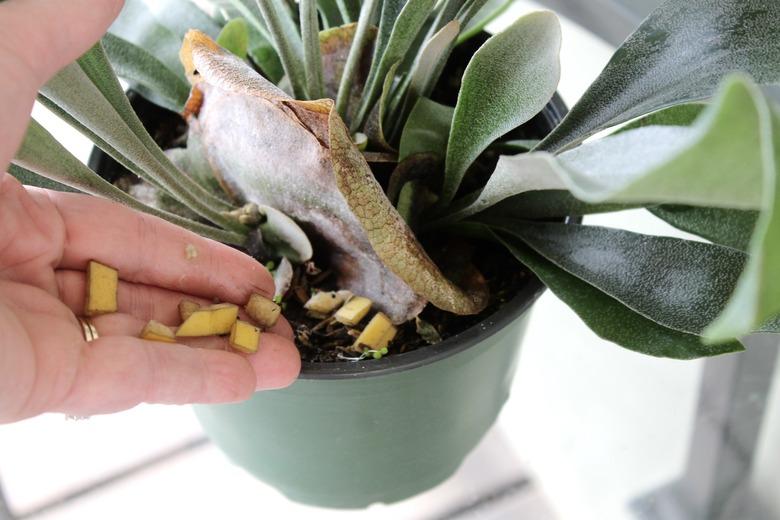How To Feed Bananas To Staghorn Ferns
Staghorn ferns (Platycerium spp.), hardy in U.S. Department of Agriculture plant hardiness zones 9 through 12, are exotic and beautiful additions to any plant collection. You can use chemical fertilizers on them in moderation or, if you prefer organic methods, you can supplement their need for potassium by feeding them banana peels.
Bananas are a high-potassium food that displaces the sodium, which can be harmful to your ferns. Staghorns are sensitive to salts and even using softened water will cause them to brown off and retard their growth. Here are three simple ways to feed staghorns with bananas.
Add Potassium From the Peel
Enjoy the banana first; then save the peels to feed your staghorn fern. Before you begin, determine the staghorn variety to ensure that you apply fertilizers, whether banana peel or a commercially prepared solution, at the correct time of year. Some varieties have dormancy periods and should not be fertilized during that period. All staghorns have a reduced need for water during the winter.
1. Prepare the Banana Peels
Make pieces of dried peel. Cut a fresh banana peel with a knife into small pieces or put large pieces into a food processor and hit it a couple of times to make the pieces smaller. Increasing the surface area by making the banana peel into smaller pieces provides more potassium for your staghorn.
2. Dry the Peels
Dry the banana peel pieces. You want to dry out the banana peel before you feed it to the staghorn to prevent it rotting or inviting pests like fruit flies. You can dry the banana peel skin-down on a paper bag or scatter the macerated pieces over a plastic film or cutting board to dry the pieces. Try to prevent the banana peel from leaching into the paper bag; you'll lose the potassium that the plant needs. You can also use a food dehydrator to dry the peels quicker than drying at room temperature, which can invite fruit flies.
3. Add Peels to the Pot
Sprinkle the dried pieces on top of the moss so the potassium leaches out whenever the plant is watered. You can also mix the pieces into the moss if you are replanting or starting a staghorn fern. If your staghorn fern is already mounted on a wooden block or in a wire cage or basket, simply tuck the dried banana peels just inside the moss near the top of the mount so that gravity will pull nutrients down around the roots when you water your plant.
4. Make Banana Water
Make banana water by tossing a fresh peel into a disposable container and adding distilled water. Let the peel soak for a day or two and use the water (not the peel) to water the staghorn. This is a quicker alternative to drying out the banana peel, unless you're using a dehydrator.
5. Plant With the Staghorn
Plant a banana peel when you mount your staghorn. Place a banana peel between the plant and the board. If you are transplanting or starting a staghorn fern on a board, place a whole banana peel between the plant and the board. This shields the peel from pests and provides the potassium when you water the plant.
Use Other Fertilizers
If you're out of bananas, consider fertilizing your fern with a 10-10-10 liquid fertilizer. A solution of 10-10-10 or 20-20-20 fertilizer or fish emulsion applied monthly during the summer and bi-monthly in winter will feed a young staghorn through the year. If you're growing your staghorn indoors, you may want to avoid using fish emulsion because of the fishy odor. Mature plants can be fed once or twice a year with a slow-release fertilizer.
1. Protect Surfaces and Yourself
Put on safety goggles and gloves before mixing and applying fertilizers. Also cover the surface under the plant with newspapers or a plastic tablecloth.
2. Prepare the Fertilizer
Combine 1/4 teaspoon fertilizer with 1/2 cup water, or adust these rates depending on product-specific label directions. If using fish emulsion, mix 1 teaspoon with 1/2 cup water, unless the product you're using recommends different amounts. Stir well, or shake in a closed container to completely mix the solution.
3. Apply Fertilizer to the Staghorn
Water first; then slowly pour the solution over the peat moss. Allow the solution to soak in; then water again to wash out any excess fertilizer.
